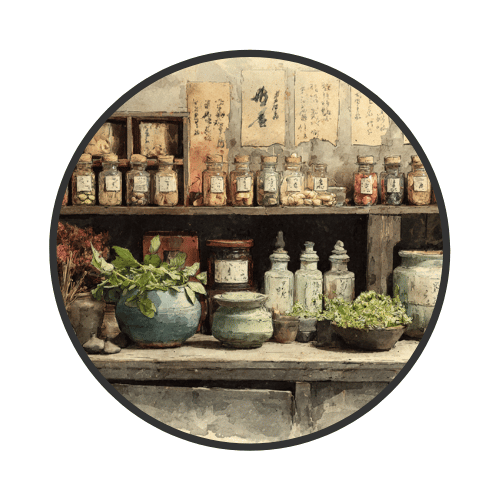Traditional Chinese medicine (TCM) is an ancient health and wellness system practiced in China that has spread throughout Asia for thousands of years. This holistic approach to healthcare is deeply rooted in Chinese philosophy, culture, and spirituality, emphasizing the balance between mind, body, and environment. TCM includes a variety of practices, such as herbal medicine, acupuncture, massage (Tui Na), exercise (Qigong), and dietary therapy, all aimed at promoting health and preventing disease.
Origins and Historical Development
The origins of TCM can be traced back to the Shang Dynasty (c. 1600-1046 BCE), with some archaeological evidence suggesting even earlier practices. The foundational theories and practices of TCM were formally documented during the Han Dynasty (206 BCE-220 CE), particularly in two seminal texts: the Huangdi Neijing (The Yellow Emperor's Inner Canon) and the Shang Han Lun (Treatise on Cold Damage Disorders).
The Huangdi Neijing, attributed to the legendary Yellow Emperor, is divided into the Suwen (Basic Questions) and the Lingshu (Spiritual Pivot). This text lays the groundwork for TCM theory, covering topics such as the principles of yin and yang, the five elements, the meridian system, and the etiology of disease. The Shang Han Lun, written by Zhang Zhongjing, focuses on diagnostic methods and treatment strategies, particularly for febrile diseases, and remains a cornerstone of TCM clinical practice.
At the heart of TCM are several fundamental principles and theories that guide diagnosis and treatment:
Yin and Yang
The concept of yin and yang represents the dualistic nature of the universe, where opposite forces are interconnected and interdependent. Yin is associated with cold, darkness, and passivity, while yang is linked to heat, light, and activity. Health in TCM is viewed as a dynamic balance between these two forces, and disease arises when this balance is disrupted.
The Five Elements
The theory of the five elements (Wu Xing) further elaborates on the interconnectedness of the natural world. The five elements—wood, fire, earth, metal, and water—represent different qualities and processes in the body and the environment. Each element is associated with specific organs, emotions, seasons, and other natural phenomena. For example, wood is linked to the liver and spring, fire to the heart and summer, earth to the spleen and late summer, metal to the lungs and autumn, and water to the kidneys and winter. TCM practitioners use this framework to understand the relationships between different aspects of health and disease.
Zang-Fu Theory
The zang-fu theory classifies the body's organs into zang (yin) and fu (yang). The zang organs include the heart, liver, spleen, lungs, and kidneys, which are considered to store vital substances such as qi (vital energy), blood, and essence. The fu organs, which include the gallbladder, stomach, small intestine, large intestine, bladder, and triple burner (a concept unique to TCM), are responsible for transforming and transporting substances. This theory emphasizes the functional relationships between organs and how they contribute to overall health.
Diagnostic and Treatment Methods
Unlike Western medicine, which focuses on specific symptoms, the TCM diagnostic Process takes a holistic approach to diagnosis by examining the whole person, considering their physical, emotional, and environmental factors. These methods help identify patterns of disharmony, which guide the selection of treatment strategies.
Practitioners use four main examination techniques:
- Observing with the naked eye things like complexion, voice, tongue color, and coating
- Listening and smelling for abnormalities
- Asking questions about symptoms, lifestyle, sleep, etc.
- Taking the pulse at three points on each wrist to assess the flow of qi
By identifying patterns of disharmony or imbalance in the yin and yang forces, excess or deficient conditions, and the strength of the five elements, practitioners can develop personalized TCM treatment plans to restore the body's balance and promote natural healing.
Herbal Medicine
Herbal medicine is a cornerstone of TCM’s holistic approach to healing. Extensive ancient texts catalog thousands of medicinal plants and their properties according to TCM principles. TCM herbalists prescribe tailored formulas with carefully crafted combinations of herbs, minerals, and natural substances to restore imbalances and treat conditions. Chinese herbal remedies can be taken as teas, powders, tinctures, or pills, personalized to address specific patterns of disharmony within each individual.
Acupuncture, Acupressure, and Moxibustion
Acupuncture involves inserting thin needles into specific points along meridians—energy pathways believed to conduct qi (life force). This technique is thought to regulate qi flow, addressing imbalances that may cause illness or pain.
Acupressure applies firm finger pressure to the same points, offering a gentler, needle-free alternative that can be used for self-treatment.
Moxibustion, often combined with acupuncture, uses a burning mugwort herb to warm and stimulate acupoints. It's believed to improve circulation and strengthen the blood. Two primary forms exist: direct (placed on the skin) and indirect (burned above the skin or on a barrier).
Qigong and Tai Chi: Harmonizing Mind and Body
Qigong and Tai Chi are ancient Chinese practices that blend gentle movement, focused breathing, and meditation to cultivate qi (life energy). Qigong emphasizes specific postures and techniques for energy cultivation, while Tai Chi flows through a series of slow, graceful martial arts movements. Both arts enhance mindfulness, flexibility, and overall well-being. As pillars of traditional Chinese medicine, they're renowned for promoting health and longevity. These practices have gained global popularity for their stress-reducing benefits and accessibility to people of all ages and fitness levels.
Modern Integration and Global Influence
In recent decades, TCM has gained increasing global recognition and acceptance beyond its Eastern roots. Many conventional medical institutions have integrated TCM therapies like acupuncture, herbal remedies, and practices such as tai chi alongside Western treatments. The holistic TCM approach is a valuable complement to providing integrative, personalized patient care. As people worldwide seek out natural, holistic pathways to wellness, practitioners and the public are embracing the timeless principles and therapies of TCM as a vital part of a comprehensive healthcare model.









Leave a comment
All comments are moderated before being published.
This site is protected by hCaptcha and the hCaptcha Privacy Policy and Terms of Service apply.